Ever dreamed of picking your own sweet figs from your yard? Growing fig trees is fun and rewarding. But, do you know how to care for them? This guide will teach you everything you need to know to grow fig trees in your garden.
Are you ready to grow your own figs? Let’s explore the world of fig trees together. We’ll find out how to make them grow well and produce lots of fruit.
Choosing the Right Fig Tree Variety
Choosing the right fig tree variety is key to growing fig trees successfully. There are many fig tree types, each suited for different climates and conditions. Let’s look at some popular fig tree varieties for your garden.
Brown Turkey Fig
The Brown Turkey Fig is a top pick for gardeners. It’s known for its sweet, juicy fruit that grows in large amounts. It can grow in many conditions, making it a great choice. This fig tree grows 10-25′ tall and 10-25′ wide, perfect for zones 5-9.
Chicago Hardy Fig
The Chicago Hardy Fig stands out for its cold tolerance and tough conditions. It gives medium-sized fruit with a sweet taste. This tree grows 10-15′ tall and 10-12′ wide, ideal for zones 6-9.
Violette de Bordeaux Fig
The Violette de Bordeaux Fig is a special heirloom type. It produces sweet purple fruit in late summer and fall. Great for small spaces or containers, it’s also known as Negronne. This fig grows 6-10′ tall and 10′ wide, fitting zones 6-10.
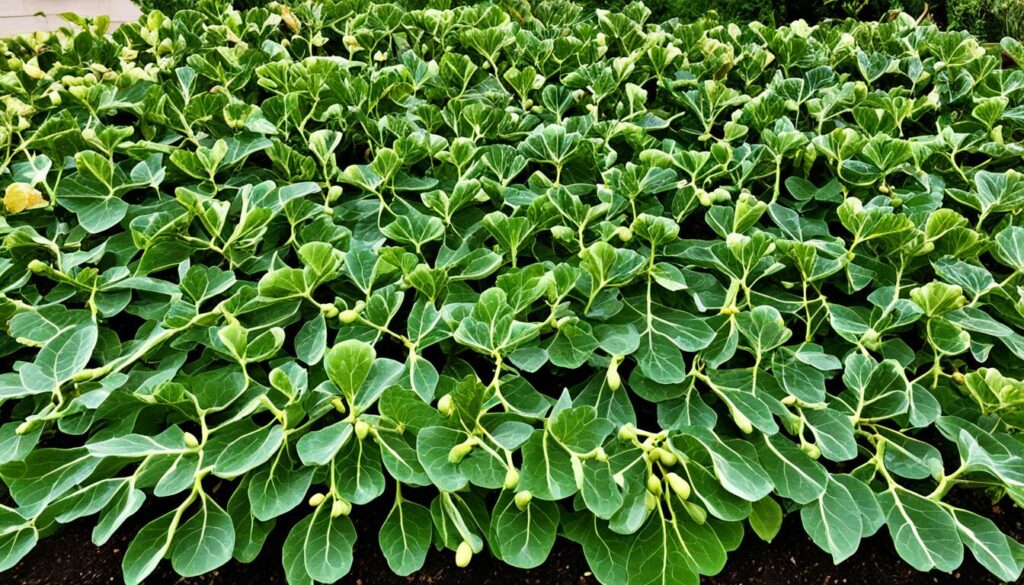
| Variety | Mature Size | USDA Zones | Fruit Color | Harvest Season |
|---|---|---|---|---|
| Brown Turkey Fig | 10-25′ tall, 10-25′ wide | 5-9 | Brown skin, red flesh | Summer to fall |
| Chicago Hardy Fig | 10-15′ tall, 10-12′ wide | 6-9 | Green/brown skin, pink flesh | Late summer to fall |
| Violette de Bordeaux Fig | 6-10′ tall, 10′ wide | 6-10 | Purple skin, red flesh | Late summer to fall |
Selecting the Ideal Planting Location
Choosing the right spot for fig trees is key to their health and productivity. They need certain conditions to grow well. Let’s look at what makes a spot perfect for planting your fig tree.
Sunlight Needs: Fig trees love lots of sunlight. They need at least 6 hours of direct sun each day. Pick a spot that gets full sun all day.
Soil Drainage: These trees like soil that drains well to avoid root rot. Stay away from places with poor drainage. If your soil is heavy clay, think about making a raised bed for better drainage.
Spatial Requirements: Fig trees can get big, reaching 40-75 feet tall and wide. Make sure you have enough room for the tree to grow without crowding other plants or buildings. Keeping them 10-35 feet apart is important for their health.
Sheltered Location: Fig trees do well in places protected from strong winds. Winds can break their branches and damage the fruit. Find a spot that’s safe from harsh weather.
By thinking about the fig tree planting location, fig tree sunlight requirements, and fig tree space requirements, you can help your fig tree thrive. This way, you’ll get lots of fruit for many years.
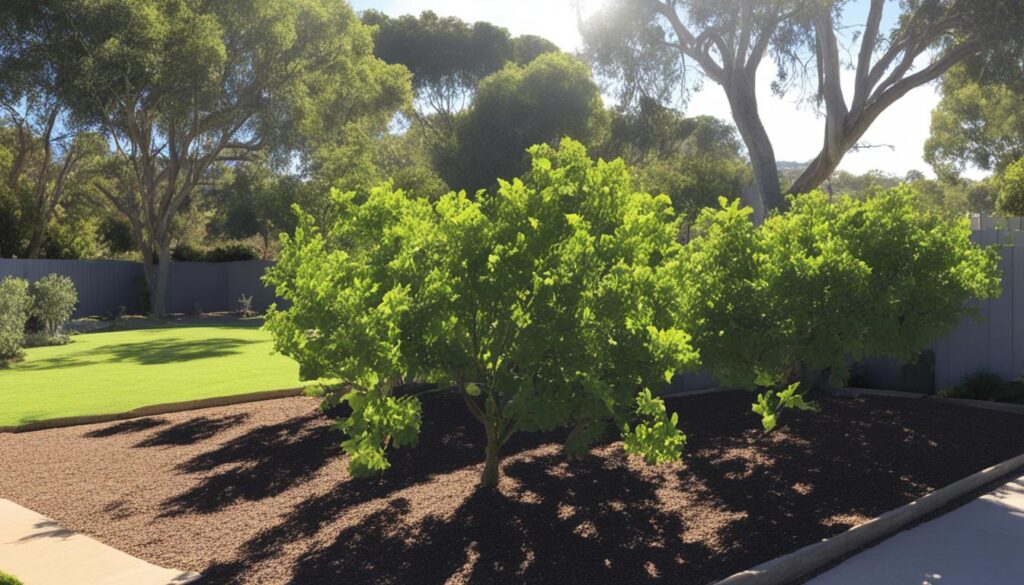
Preparing the Soil for Fig Trees
To grow fig trees well, start with the right soil. They like soil that drains well and is full of nutrients. The soil should be a bit acidic, with a pH between 6.0 and 6.5.
For your fig tree, focus on two things: drainage and adding organic matter.
Improving Soil Drainage
Fig trees don’t like wet, hard soil. This can cause root rot and other problems. To fix this, add organic stuff like compost or manure to the soil.
This makes the soil easier to dig through and lets air in. If your soil is heavy or clay-like, add sand or gravel to help it drain better.
Adding Organic Matter
Fig trees do well in soil full of organic stuff. Use compost, manure, or other rich amendments to feed the soil. This helps your tree grow strong and keeps the soil moist.
Preparing the soil right sets your fig tree up for success. With great soil, your tree will grow strong roots and give you lots of tasty figs.
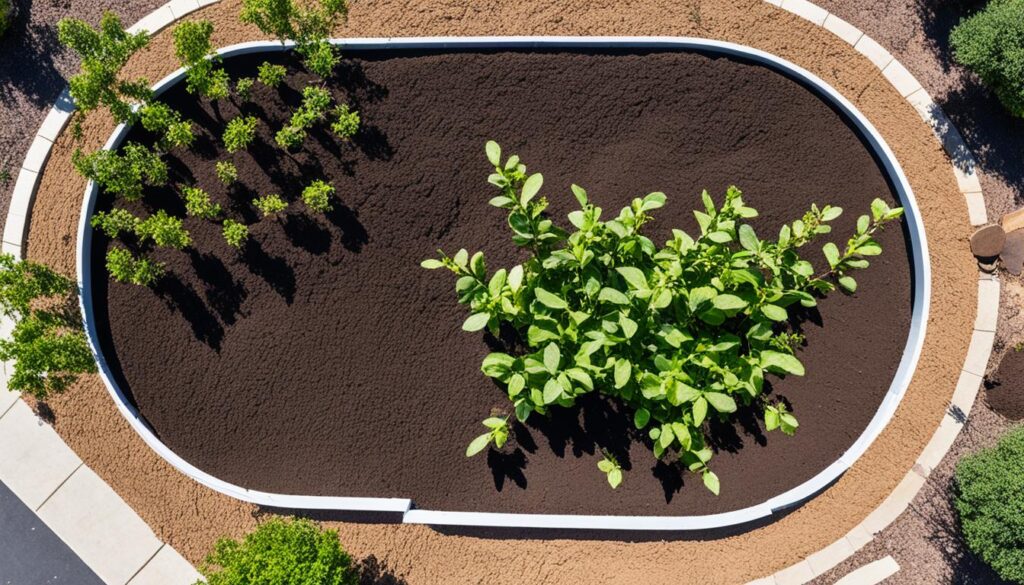
Planting Your Fig Tree
Planting your fig tree right is key. Make sure the hole is only 1 foot wider than the roots. This means leaving 4-6 inches of space around the roots. It helps the tree adjust easily and grow strong roots.
Put compost and soil in the hole, then water the tree well after planting. Fig trees do best when planted in early spring. This gives them time to grow strong roots before the cold weather comes.
| Planting Depth | Planting Hole Size | Planting Time |
|---|---|---|
| Plant at the same level as the pot | 1 foot wider than the rootball | Early spring |
By following these tips, you’ll help your fig tree grow well. It will give you lots of fruit in the future.
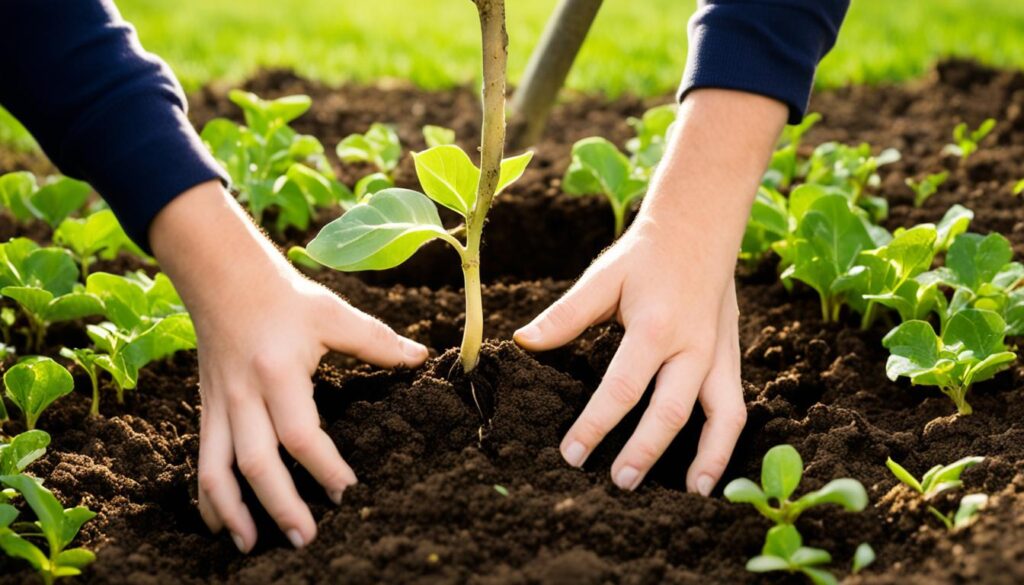
Caring for Your Fig Trees
Looking after a fig tree means making sure it gets enough water and the right nutrients. By knowing what your fig trees need, you can help them grow well and produce lots of fruit.
Watering Needs
Fig trees like their soil to be moist but not soaked. Water them deeply once a week, and more often if it’s dry. Keep the soil moist but not too wet to avoid root rot and other issues.
Fertilizing Requirements
Fig trees eat a lot and need regular fig tree fertilizing to grow and produce fruit. Use a balanced organic fertilizer with nitrogen, phosphorus, and potassium every 4-6 weeks when they’re growing. This helps your fig tree get the fig tree nutrient needs it needs to do well.
- Put the fertilizer around the tree’s drip line, not too close to the trunk.
- Change how much fertilizer you use based on your tree’s size and age. Younger trees need less, and older trees need more.
- Don’t over-fertilize, as it can make the tree grow too much foliage and not enough fruit.
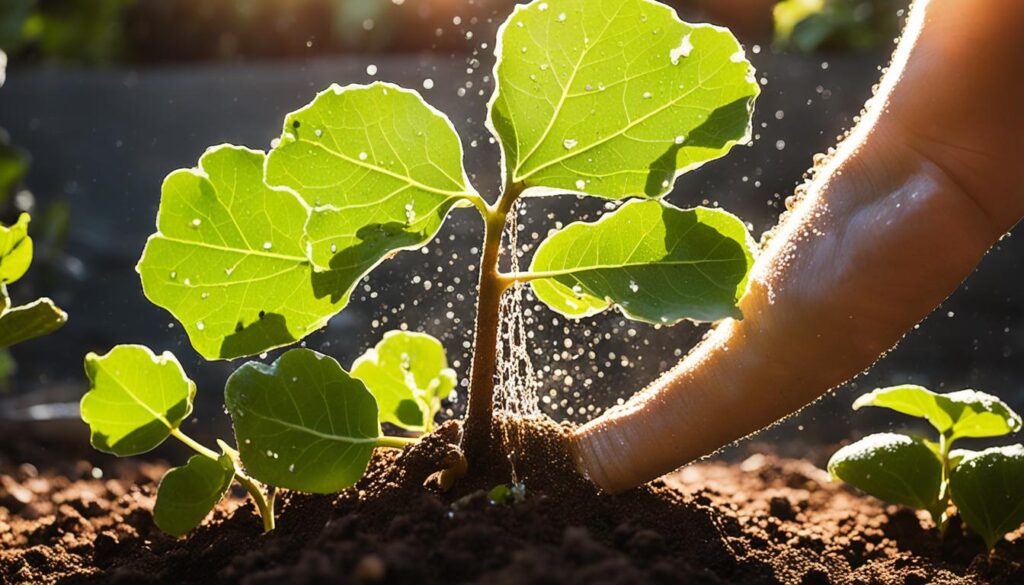
By following these fig tree watering and fig tree fertilizing tips, you can make sure your fig trees are happy and give you lots of tasty figs.
Pruning Fig Trees
Proper pruning is key for your fig trees’ health and fruit production. It helps shape their growth, boosts fruit yield, and keeps them looking good.
Pruning Young Fig Trees
In the first few years, make sure the tree has a strong leader and balanced branches. Prune in the dormant season, cutting back half of last year’s growth. Choose the strongest branches and trunk.
Remove suckers at the tree’s base. Prune every year to make the tree strong and healthy.
Pruning Mature Fig Trees
For mature trees, prune lightly each year to keep them looking good and productive. Cut out dead or sick branches. Also, remove some branches for better light and air flow.
Prune about one-third of last year’s growth to help the tree focus on making fruit.
Proper fig tree pruning is key for their health and fruit. By pruning young and mature fig trees right, you’ll get lots of fruit for years.
Harvesting Fig Fruits
Growing fig trees needs careful attention. The best part is when you get to harvest them. It’s important to know when and how to pick your figs for the best taste.
Fig trees can grow up to 50 feet tall, but most are 10 to 20 feet tall. The best time to pick figs is when they feel soft and have a bit of wrinkles on their skin. This means they are ripe and ready to eat.
To pick figs, gently take them off the tree. Be careful not to hurt the fruit or the tree. It’s best to pick them in the morning on a cloudy day. In the northern hemisphere, you can pick figs from July to September. The first ones ripen in July, and the last ones in September.
| Variety | Ripening Timeline |
|---|---|
| Brebas | July |
| Early and Midseason | August |
| Late-Ripening | September |
After picking, you can eat figs fresh, make preserves, dry them, or roast them. To keep them fresh, store them in the fridge for up to three days. You can also freeze them for up to three years or dry them for longer storage.
Knowing when and how to pick your figs ensures you get a lot of delicious fruit every year.
fig trees Propagation Methods
Propagating fig trees is fun and rewarding for gardeners. You can use cuttings and seeds to grow new trees. Each method has its own benefits and things to think about.
Propagating from Cuttings
Taking cuttings from a fig tree is a simple way to grow more trees. Do this in the dormant season, after the last frost, usually in late fall or early winter. Pick a healthy branch that’s 8-12 inches long and dip it in rooting hormone to help roots grow.
Put the cutting in a pot with good drainage, like ProMix BX formulation. Keep the soil moist. A heat mat helps keep the soil warm, which is key for roots to grow. Some people seal the cutting tips with melted wax or wax tape to keep moisture in.
Growing from Seeds
Growing fig trees from seeds is harder but can be rewarding. You need female fig seeds. Soak them in water to see if they’re alive, then plant them in a seed starting tray with good potting mix. They should start growing within a week or two.
Seeds may take a few years to grow into fruit-bearing trees. But it’s a fun learning experience for gardeners. Remember, fig trees need 6-8 hours of sunlight a day to grow and produce fruit.
Choosing how to propagate fig trees depends on you. Either way, they add value to your garden. They give you lots of sweet figs and make your garden look better.
Growing Fig Trees in Containers
You don’t need a big backyard to enjoy fresh figs. You can grow fig trees in containers and still get to taste their deliciousness. Smaller fig types like ‘Little Figgy,’ ‘Brown Turkey,’ and ‘Chicago Hardy’ do well in pots.
For container-grown fig trees to do well, pick the right pot and soil. Use a pot with lots of drainage holes. Fill it with soil full of organic stuff. This helps with drainage and gives your fig tree the nutrients it needs.
Figs in pots have a big plus: they don’t get too big. A 5-gallon pot can give you up to 75 figs a season. A 3-5 gallon tree might give you 50-75 figs in its 2nd or 3rd year. And a big tree in a 10-15 gallon pot can give you 150-200 figs every year.
But, container-grown fig trees need extra care in winter. You’ll need to bring them inside or cover them up to keep them safe. With some planning and care, you can enjoy figs every season, even on your patio or balcony.
Overwintering Fig Trees
If you live in a place with cold winters, protecting your fig trees is key. The right steps can help you avoid a bad harvest next year.
For fig trees in pots, just move them inside. Put them in a basement or garage where it’s warm and safe. Make sure to water them once a month. Wait until the top 2-3 inches of soil are dry before you water again.
For fig trees in the ground, you’ll need to work a bit harder. Cover the trunk and roots with burlap or make a tent around the plant. Then, add a thick layer of mulch at the base. This will keep the roots warm.
- Wrap the trunk and roots in burlap or create a protective tent-like structure around the plant.
- Add a thick layer of mulch, about 6-12 inches, around the base of the tree to insulate the roots.
- Water dormant in-ground fig trees once a month, keeping the soil just moist.
By following these easy steps, you’ll make sure your fig trees make it through the winter. With a little care, you can enjoy lots of tasty figs next year, even in cold places.
Troubleshooting Common Problems with fig trees
Growing fig trees can be rewarding, but you might face some issues. Problems like not enough sunlight, poor soil, and not pruning can lower fruit production. Pests and diseases like root-knot nematodes, leaf spots, and twig dieback can also harm your tree.
Fig rust is a common problem. It makes leaves turn yellow-brown and fall off in late summer or early fall. You’ll see rust spots on the leaves’ underside. To fight fig rust, use a dormant spray with fungicides, prune for better air flow, and use drip irrigation to reduce leaf moisture.
Pink blight is another issue. It’s a fungus that covers branches with a pink to white coating, spreading to healthy parts. Fig mosaic virus, spread by eriophyid mites, causes yellow spots on leaves that turn rust-colored over time.



